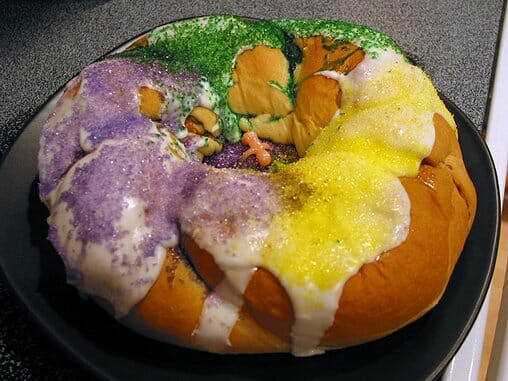A Short History of King Cake’s Long History

Mardi Gras literally translates to Fat Tuesday, indicating a period of feasting before fasting. The signature treat of that Carnival feast is, without a doubt, the King Cake. Between bites, one might wonder how this ‘o’ shaped, sugar coated, baby-packing sweet came into existence. The history of the cake is braided with Carnival’s history, and for that, it’s necessary to look back to ancient times.

The Lupercalian Festival in Rome (ca. 1580-1610), by Circle of Adam Elsheimer
Like many contemporary western holidays, Carnival is believed to have its roots in ancient pagan festivals. (Halloween from Samhain, Christmas from Yule). Carnival had two influences, Lupercalia and Saturnalia. Set in mid-February, Lupercalia celebrated rushing in the fertility spring, both for the coming harvest and humans. Saturnalia, celebrated in December included the ritual of temporarily switching the hierarchical roles through a bean hidden inside a cake.

The French Galette des Rois
The bean hidden inside the Saturnalia cake was the fava bean, and he or she who found it would be temporarily crowned ruler for the day. This ancient legume was considered magical in pagan times, blessed in monotheistic times. As ancient civilization gave way to medieval civilization and Christianity became the predominant religion in Western Europe, people still clung to their traditional celebrations, but the significance shifted.
Larousse Gastronomique notes that “During the Saturnalia the ‘king of the day’ was chosen by lot, using a bean concealed in a galette. It was only in the Middle Ages that this cake ceremony began to be associated with the festival of Epiphany.” January 6th became the day of the Epiphany. The holiday commemorates the twelfth day after Christmas, when the wise men followed the star of Bethlehem to the nativity and bring baby Jesus gifts of frankincense, gold, and myrrh. The Epiphany, also known as Three Kings Day, marks the beginning of King Cake season in New Orleans.
Three Kings day was celebrated in various Medieval European countries. Francophone countries had the Galette des Rois. Spain had the Rosca de Reyes, Portugal the Bolo Rei. The French cake galette is a flaky, golden, puff pastry with frangipane inside. Food historian, Pierre Leclercq, believes that this cake is very similar to the Saturnalia cake, given its hue and shape that reflect the sun.

The fava bean next to the St. Joseph figurine
In France, the cake continued to be baked with the object inside, but to distance itself from its pagan roots, the custom became to put a small, ceramic crown instead. During the French revolution, a time when kings were being beheaded, playing king for the day was a politically volatile act. In 1794, Paris’ revolutionary mayor is quoted as having incited his people to, “discover and arrest the criminal patissiers and their filthy orgies which dare to honor the shades of the tyrants!” Soon after, the French custom became to have a variety of ceramic charms, though they still bear the name of the original fava bean: la fève.
Louisiana’s celebration of Mardi Gras is as old as its founding. In 1699, French-Canadian explorer, Pierre Le Moyne d’Iberville, landed on the soil 60 miles south of what is today New Orleans. Coincidentally, the day he landed was the eve of Mardi Gras. He named the land, “Point du Mardi Gras,” and celebrated Fat Tuesday that very week.
New Orleans was established in 1718 by Iberville’s younger brother, Bienville. As the area grew, so did its carnival celebration, with Louisiana’s governor, the Marquis de Vaudreuil, introducing society balls in the 1740s. Rex Krewe was founded in 1872, and their colors – purple, green, and gold – became adopted as the official Mardi Gras colors.

The Spanish and Latin American Rosca de Reyes
-

-

-

-

-

-

-

-

-

-

-

-

-

-

-

-

-

-

-

-

-

-

-

-

-

-

-

-

-

-

-

-

-

-

-

-

-

-

-

-












































